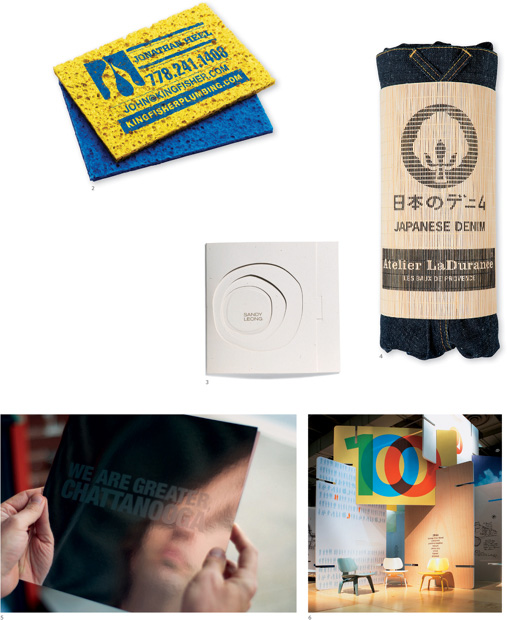44 “Image” as a Verb
New imaging and production techniques have thrown the doors wide open for identity programs. From wrapped buildings and vehicles to backlit projections and temporary tattoos, opportunities for creative surface treatments for identities abound.
Graphic identity design has advanced along with technology, inspiring some designers to create graphically complex marks, some of which blur the line between illustrative logos and illustrations. Remember not to jettison clarity and legibility to make way for creative complexity. Often, a more intricate mark requires a simpler application, while a more straightforward mark can lend itself to busier applications.
Even though there are new production techniques, basic design principles remain constant. The goal remains to evolve a distinctive identity into an effective program. Identity programs have constraints based on audience appropriateness and strategic alignment with brand objectives. Be informed and inspired by new production options for identity programs as they arise, but don’t be too driven by them.
1. Abaltat
Detail. Design Studio
2. Kingfisher Plumbing
Spring Advertising
Perry Chua, Shon Tanner, Sami Christianson
3. Sandy Leong
The O Group
Jason B. Cohen, J. Kenneth Rothermich
4. Atelier LaDurance
StormHand
Boy Bastiaens
5. Community Foundation of Greater Chattanooga
Maycreate
Brian May, Monty Wyne, Chris Enter
6. Herman Miller ICFF
People Design

5 Benefits of Digital Printing
SOURCE
Bruce Hansen A veteran of 40 years in the printing industry
Printing aficionados might cringe at the thought, but the days of hot type are over. Digital technology has affected every aspect of the printing industry—and it’s here to stay. While the quality of digital printing may never possess the oldfashioned craftsmanship of traditional methods, it can benefit designers and design buyers in a number of ways.
1. Timeliness
Speed is improving rapidly. A printing project that would have required a six-week process in 2007 can be done in a week and a half in 2010.
2. Proofing
Back when the industry was working in analog, no two proofs looked the same. Today, the digital process not only means more consistent proofs, but also the opportunity to find and fix more mistakes.
3. Reproofing
Not long ago, if you were on press and discovered a problem with photography, it would have added a week to the printing schedule. Now you can retouch it and reproof it on the fly.
4. Print on demand
Many companies are moving to print on demand. By posting a file in PDF format, they can allow their clients to select prescripted pages and prescripted photos, and print their own small quantities of the project. The quality will suffer, but the cost savings will continue to prompt companies to go with this option.
5. Lower expectations
“Good enough” satisfies 99 percent of the people 99 percent of the time. Designers might be able to tell the difference between a project printed digitally and a project printed with traditional production methods, but if the difference is imperceptible to the audience for a piece, is it worth investing the time and money necessary to get it perfect?
Spongy business cards, four-color billboards, laser-precision diecuts: It’s all on the table with today’s production technology.

